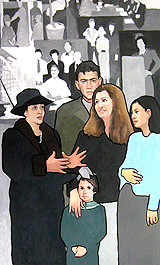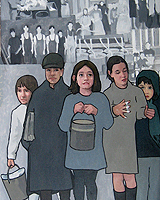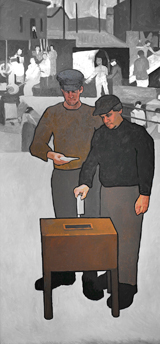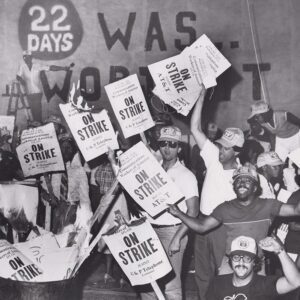June 30, 2011
Maine Governor Removes Artist’s Labor Tribute
The Republican governor of Maine has censored an artist’s tribute to the state’s workers — infuriating unions and many others who called it a brazen attempt to erase decades of labor history.
In March, Gov. Paul LePage ordered the state’s Department of Labor to remove a mural from its headquarters in Augusta that depicts more than a century of workers’ struggles. Claiming that such tributes are “not in keeping with the department’s pro-business goals,” LePage also ordered that the names of two labor icons — Frances Perkins and Cesar Chavez — be stripped from conference rooms. The symbolic gesture revealed LePage’s agenda, critics said.
 With attention focused on the struggle of workers in Wisconsin and other states to defend the right to collective bargaining, the governor’s orders gained national media coverage. The directives were widely condemned by unionists, historians, artists, and editorial writers. Don Berry, president of the Maine AFL-CIO, said, “No matter what you name a room, no matter how many pictures you take down, the truth is that this state was built by and for working people, and this move dishonors the generations of hard-working Mainers who came before us.”
With attention focused on the struggle of workers in Wisconsin and other states to defend the right to collective bargaining, the governor’s orders gained national media coverage. The directives were widely condemned by unionists, historians, artists, and editorial writers. Don Berry, president of the Maine AFL-CIO, said, “No matter what you name a room, no matter how many pictures you take down, the truth is that this state was built by and for working people, and this move dishonors the generations of hard-working Mainers who came before us.”
An editorial in the Bangor Daily News compared LePage’s actions to a theme in George Orwell’s nightmarish novel, 1984, in which history was rewritten to conform to “Big Brother’s” government propaganda. “Reading 1984 is required to understand what’s happening at the state Department of Labor,” the editorial said. “Some of the department’s symbols — a mural, the names of conference rooms — are being sent down the memory hole by the LePage administration.”
Problems for LePage
Following LePage’s orders, the mural was removed and stored in an undisclosed location, where it remains at press time. Labor activists have filed a lawsuit against the governor to have the mural restored, while LePage grapples with the thorny problem of finding the money to refund a U.S. Department of Labor grant that paid for a portion of the mural. Under the Reed Act, the state is required to repay 63 percent of the artwork’s current market value if it is not displayed in a public place. Taylor was paid $60,000 for the project, which took her a year to research and produce, but arts critics now say the mural’s value is much higher — thanks to publicity LePage gave it.
Union members led a protest at the state house on April 4, carrying photographic cutouts of the governor’s head and signs that said “Fear No Art,” “LePage Must Go,” and “Without Labor There Is No Business.” The crowd chanted “Put it back, put it back, put it back,” urging legislators to intervene. A YouTube video in which the mural was beamed onto the statehouse “went viral,” and a petition is being circulated to recall the governor.
Insult Added to Injury
Gov. LePage — who was elected in 2010 with strong support from wealthy, anti-labor donors — has drawn criticism from lawmakers on both sides of the aisle. Considered an extreme conservative by most accounts, the governor is no stranger to controversy. In recent months, he said that President Barack Obama could to “go to hell,” and that the NAACP could “kiss my butt.”
 After LePage called critics of his decision “idiots,” eight Republican Maine state senators responded: “We feel compelled to express our discomfort and dismay with the tone and spirit of the remarks he has made,” they wrote in an April 4 column. “Government by disrespect should have no place in Augusta, and when it happens, we should all reject it.”
After LePage called critics of his decision “idiots,” eight Republican Maine state senators responded: “We feel compelled to express our discomfort and dismay with the tone and spirit of the remarks he has made,” they wrote in an April 4 column. “Government by disrespect should have no place in Augusta, and when it happens, we should all reject it.”
LePage’s policy proposals, however, go beyond hot-headed rhetoric, and are aimed at Maine’s working families: He wants to raise healthcare costs for state workers and teachers, loosen child labor laws, and cut the minimum wage for workers under age 20 by $2.50 an hour — while giving over $200 million in tax cuts to corporations and wealthy individuals. LePage also supports so-called “Right to Work” laws, which hobble union organizing efforts.
Erasing History
LePage’s decision to banish the tribute to Maine workers continues to draw condemnation.
The governor’s “effort to erase this past is dangerous,” said Georgetown University history professor Joseph McCartin, “More than a mere exercise in political score settling, it is an effort to rewrite the nation’s history, erasing unions from it.”
“We need more labor history, not less,” said APWU President Cliff Guffey. “Too many Americans don’t know that unions helped create the great American middle-class and the highest living standards the world has ever known.”
[(01/14/13) Maine Labor History Mural Back on Public Display]
An Artist’s Tribute
The 36-foot-long, eight-foot-tall mural, created in 2007 by artist Judy Taylor, consists of 11 panels that depict how the state’s stone cutters, timber and textile workers, and shipyard laborers organized for better wages and working conditions. The mural also notes the struggles of children and women in the workplace, honors the women who built battleships during World War II, and commemorates the two largest labor strikes in Maine history: A 1937 shoe factory strike in Auburn, and a 1986 mill workers’ strike against the International Paper Company in Jay.
“Each panel in the mural is an allegory for a struggle or an achievement in the labor movement,”Jason Horowitz wrote inThe Washington Post.
One panel pays tribute to Frances Perkins, who served as Secretary of Labor during Franklin D. Roosevelt’s presidency. Perkins had deep roots in Maine and helped pass legislation that granted workers the right to organize and bargain collectively, and established the national minimum wage, the 40-hour work week, and Social Security.




